Lt. Col. C.G. “Jug” Gerard
U.S. Marine Corp.
Marine Observation Squadron 6
Phu Bai, Vietnam. ’56-81
U.S. Marine Corp.
Marine Observation Squadron 6
Phu Bai, Vietnam. ’56-81
Jug Gerard spent 25 years in the Marine Corp beginning in 1956 as a Naval Aviation Cadet. His goal was to become a Marine fighter pilot. He spent three years of A-4C jet attack training, and he successfully completed the training in 1963. Much to his surprise, and the surprise of 550 other fixed wing pilots, he received order to helicopter training. At that time the Vietnam War was on the horizon and military planners were ordering new turbine-jet engine helicopters to replace the aging fleet of reciprocating engine helicopters.
After completing his transition training Jug received orders VMO-1, a visual observation squadron. In 1964 he began training and became proficient flying the Huey and other new helicopters entering service. In September 1967 Jug deployed to Vietnam and was assigned to VMO-6. Jug said the next 13 months were considered the most active period of the war. By this time Jug had been promoted to Major and was given the lead of his squadron.
The Huey was equipped with four forward machine guns, two 2.75 inch rocket pods and two crew-man side firing guns. Hueys were often responsible to defending CH-46 transport helicopters. Jug felt the most satisfying missions were when he unit served as the forward air-controller. The Marines on the ground who needed air support would relay the locations of the enemy where they needed bombs dropped and the Hueys would relay that information to the jet fighters who could deliver the much-needed ordnance. The Hueys would fly low to identify where the jet should drop their bombs and mark the area with white phosphorus smoke.
Jug’s group also worked closely with Marine Reconnaissance Teams (Recon). The Recon teams were on the ground gather intelligence on enemy positions and movements. The Hueys would insert the Recon teams and later extract them, often under heavy fire. Jug found the Recon missions tense and challenging.
In 1967 their base was moved north to Quang Tri, 15 miles south of the DMZ. The action in this area was quite heavy. His squadron became the sole helicopter support for the combat base at Khe Sahn. All of the supplies for the base came in by transport helicopter because the road, Highway 9, was cut off. In January of 1968 Jug was assigned to Khe Sahn base. A small contingent of helicopters were parked at Khe Sahn to reduce response times. In addition to providing protection to the transport helicopters on supply missions they flew daily intelligence gathering flight in and around the area looking for the enemy.
In late January the NVA began an all-out attack on Khe Sahn, known as the “Siege of Khe Sahn”. Jug and his team flew daily air control missions, escorted the transport helicopters and served on overnight standby call. Eventually the Army gained control of the area, the NVA retreated, and the tempo dropped off.
In September of 1968 Jug returned to the US having earned two Distinguished Flying Cross with Gold Star medals, 2 Bronze Star with V for Valor medals, Navy and Marine Corp Commendation Medal with V and a handful of others. He landed in San Francisco dressed in his uniform and was greeted with stares, hisses and finger pointing from the anti-war crowd. He got a haircut in the airport terminal from an anti-war supporter who gave him a lecture on why we shouldn’t be in Vietnam. That earned him no tip. On his flight home to St Louis the flight attendant didn’t wake him up for the meal service. When he awoke, he asked if there was any chance, he could get a bite to eat. The flight attendant said, “you missed your chance, soldier boy.”
Jug remained in the service and eventually was part of the teaching faculty at the Armed Forces Staff College in Norfolk, VA. Jug retired in 1981 as a Lt Col.
Jug, thank you for service and sacrifices and a very difficult combat zone. Also accept our apologies for the poor behavior
After completing his transition training Jug received orders VMO-1, a visual observation squadron. In 1964 he began training and became proficient flying the Huey and other new helicopters entering service. In September 1967 Jug deployed to Vietnam and was assigned to VMO-6. Jug said the next 13 months were considered the most active period of the war. By this time Jug had been promoted to Major and was given the lead of his squadron.
The Huey was equipped with four forward machine guns, two 2.75 inch rocket pods and two crew-man side firing guns. Hueys were often responsible to defending CH-46 transport helicopters. Jug felt the most satisfying missions were when he unit served as the forward air-controller. The Marines on the ground who needed air support would relay the locations of the enemy where they needed bombs dropped and the Hueys would relay that information to the jet fighters who could deliver the much-needed ordnance. The Hueys would fly low to identify where the jet should drop their bombs and mark the area with white phosphorus smoke.
Jug’s group also worked closely with Marine Reconnaissance Teams (Recon). The Recon teams were on the ground gather intelligence on enemy positions and movements. The Hueys would insert the Recon teams and later extract them, often under heavy fire. Jug found the Recon missions tense and challenging.
In 1967 their base was moved north to Quang Tri, 15 miles south of the DMZ. The action in this area was quite heavy. His squadron became the sole helicopter support for the combat base at Khe Sahn. All of the supplies for the base came in by transport helicopter because the road, Highway 9, was cut off. In January of 1968 Jug was assigned to Khe Sahn base. A small contingent of helicopters were parked at Khe Sahn to reduce response times. In addition to providing protection to the transport helicopters on supply missions they flew daily intelligence gathering flight in and around the area looking for the enemy.
In late January the NVA began an all-out attack on Khe Sahn, known as the “Siege of Khe Sahn”. Jug and his team flew daily air control missions, escorted the transport helicopters and served on overnight standby call. Eventually the Army gained control of the area, the NVA retreated, and the tempo dropped off.
In September of 1968 Jug returned to the US having earned two Distinguished Flying Cross with Gold Star medals, 2 Bronze Star with V for Valor medals, Navy and Marine Corp Commendation Medal with V and a handful of others. He landed in San Francisco dressed in his uniform and was greeted with stares, hisses and finger pointing from the anti-war crowd. He got a haircut in the airport terminal from an anti-war supporter who gave him a lecture on why we shouldn’t be in Vietnam. That earned him no tip. On his flight home to St Louis the flight attendant didn’t wake him up for the meal service. When he awoke, he asked if there was any chance, he could get a bite to eat. The flight attendant said, “you missed your chance, soldier boy.”
Jug remained in the service and eventually was part of the teaching faculty at the Armed Forces Staff College in Norfolk, VA. Jug retired in 1981 as a Lt Col.
Jug, thank you for service and sacrifices and a very difficult combat zone. Also accept our apologies for the poor behavior

